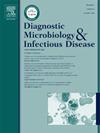新生儿呼吸窘迫综合征与早期呼吸道微生态变化相关
IF 2.1
4区 医学
Q3 INFECTIOUS DISEASES
Diagnostic microbiology and infectious disease
Pub Date : 2025-04-17
DOI:10.1016/j.diagmicrobio.2025.116848
引用次数: 0
摘要
目的探讨新生儿呼吸窘迫综合征患儿早期呼吸道微生物群的分布规律。方法选取2022年7月至10月昆明儿童医院新生儿科收治的新生儿呼吸窘迫综合征患儿为研究对象。在入院后1 ~ 3天(初始组)和入院后7 ~ 10天(后组)两个时间点采集样本。采用16S核糖体RNA基因测序分析咽拭子和下呼吸道痰液样本,评估早期气道微生物组的组成和变化。结果出生后1 ~ 3天和7 ~ 10天咽、下呼吸道痰液中检出的优势菌群包括链球菌、肠杆菌、盐单胞菌、不动杆菌和沙雷氏菌,其中以前3种菌最占优势。微生物分布模式在两种样品类型的初始组和后期组之间基本一致,表现出最小的年龄相关变化。与初始组相比,后处理组微生物群落丰富度较高,多样性较低,但差异无统计学意义。值得注意的是,初始组和后期组咽菌群的丰富度指数、ACE指数和Chao1指数均存在显著差异。结论新生儿呼吸窘迫综合征患儿的呼吸道微生物组成在出生后1 ~ 3天和7 ~ 10天保持相对稳定,但随着年龄的增长,呼吸道微生物群的丰度和多样性发生了变化。本文章由计算机程序翻译,如有差异,请以英文原文为准。
Changes in early respiratory tract microecology associated with neonatal respiratory distress syndrome
Objective
This study aimed to explore the distribution patterns of the early respiratory tract microbiome in infants with neonatal respiratory distress syndrome.
Methods
The study involved infants with neonatal respiratory distress syndrome who were admitted to the neonatal department of Kunming Children’s Hospital between July and October 2022. Samples were obtained at two time points: 1 to 3 days post-admission (initial group) and 7 to 10 days post-admission (later group). Pharyngeal swabs and lower respiratory tract sputum samples were analyzed using 16S ribosomal RNA gene sequencing to assess the composition and variations of the early airway microbiome.
Results
The predominant microbiota identified in both pharyngeal and lower respiratory tract sputum samples at 1 to 3 days and 7 to 10 days after birth included Streptococcus, Enterobacter, Halomonas, Acinetobacter, and Serratia, with the first three being the most dominant. The microbial distribution patterns were largely consistent between the initial and later groups in both sample types, exhibiting minimal age-related variation. Although the later group demonstrated higher microbial community richness and lower diversity compared to the initial group, these differences were not statistically significant. Notably, significant differences were observed in the richness index, ACE index, and Chao1 index of the pharyngeal microbiota between the initial and later groups.
Conclusion
The respiratory tract microbial composition in infants with neonatal respiratory distress syndrome remained relatively stable between 1 and 3 days and 7 to 10 days post-birth, although changes in the abundance and diversity of the respiratory tract microbiota were observed with advancing age.
求助全文
通过发布文献求助,成功后即可免费获取论文全文。
去求助
来源期刊
CiteScore
5.30
自引率
3.40%
发文量
149
审稿时长
56 days
期刊介绍:
Diagnostic Microbiology and Infectious Disease keeps you informed of the latest developments in clinical microbiology and the diagnosis and treatment of infectious diseases. Packed with rigorously peer-reviewed articles and studies in bacteriology, immunology, immunoserology, infectious diseases, mycology, parasitology, and virology, the journal examines new procedures, unusual cases, controversial issues, and important new literature. Diagnostic Microbiology and Infectious Disease distinguished independent editorial board, consisting of experts from many medical specialties, ensures you extensive and authoritative coverage.

 求助内容:
求助内容: 应助结果提醒方式:
应助结果提醒方式:


